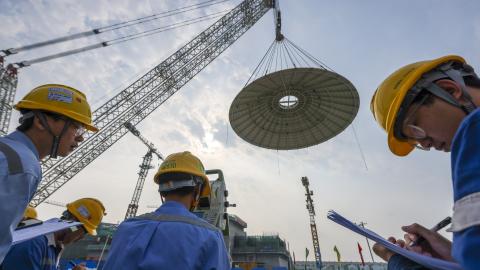The growing so-called “no-limits” or now “new era” partnership between Russia and China isn’t a new phenomenon, but it is one that has significantly metastasized since Russia’s renewed invasion of Ukraine in February 2022. The Russians and Chinese now commonly cooperate on space, missile defense, and imagery and intelligence sharing. What was until recently a partnership that existed between two leaders—largely fortified by their personalities alone—now permeates down into the ranks of the security services through cooperation on joint training, exercises, technical exchanges, sanctions evasion, and on Ukraine. There was new life breathed into that relationship last week when Russian president Vladimir Putin made his first “post re-election” trip abroad to China to bend a knee to and embrace Chinese premier Xi Jinping.
Regrettably, there is no greater example of China’s no-limits aid to Russia than in Ukraine. On April 19, 2024, Secretary of State Antony Blinken stated that China’s provision of military technology was fueling "the biggest threat to European security since the end of the Cold War." By this he presumptively meant that the Chinese provision of key parts, components, and technologies, in circumvention of U.S. and European export controls and sanctions were directly enabling Putin to prosecute his war of aggression. The fact that that they are doing so in direct contravention of a red-line issued by President Biden two-years ago is not lost on our enemies.
While the partnership between Russia and China has deepened, a key power dynamic has been flipped on its head. In nearly every aspect or commodity where Russia used to dominate, that role is occupied by China. For example, Russia is currently dependent on China for semiconductors, aeronautics equipment, microelectronics, chemical precursors, and energetics. As a result, Russia’s war machine is fueled by China’s exploitation of human capital.
The truth is that the Russian population is contracting – and not just at the hands of Ukrainian bullets, but due to low birth-rates, a substandard living condition, and terrible healthcare. Russia’s population of just under 150 million, could fall to the low-130s by the middle of the century. Meanwhile, China currently has a population of over 1.4 billion. These trends will only further entrench Putin’s role of beta in the Sino-Russian relationship and increase the degree to which Russia is dependent on China – a dependency that one day Xi will look to exploit.
For the time being, the lone sector where Russia reigns supreme is energy – particularly in the nuclear realm. Rosatom, Russia’s state-owned nuclear energy company, is Putin’s “ace in the hole,” and he plays it frequently. China is reliant on Russian energy to heat its homes and to power its manufacturing facilities. It allows the Chinese economy and a population of 1.4 billion to produce the products that Russia relies on and to do so at scale. And while China is self-sufficient in many ways, a population of 1.4 billion people has a way of putting a strain on a country’s energy grid – even one as large and diverse as China’s.
Russia’s energy dominance isn’t limited to just China. Most public reports have Rosatom working on over 20 nuclear power units across the globe including in India, Turkey, and Egypt, with foreign bookings standing at over $200 billion. The U.S. alone pays an additional $1 billion to Rosatom. European Union states, many of which were burned by their missteps on Nord Stream 2, should be incentivized the most to get off Russian energy, but instead seem to actually be increasing their reliance on Russian uranium. By continuing to do business with Rosatom, the United States and Europe are indirectly funding both sides of the Ukrainian conflict.
But the reliance isn’t simply on the civilian side. President Biden’s Assistant Secretary for Space, Dr. John Plumb recently testified Rosatom was in fact fueling China’s nuclear military breakout. He stated “It’s very troubling to see Russia and China cooperating on this…They may have talking points around it, but there’s no getting around the fact that (fast)-breeder reactors are for plutonium, and plutonium is for weapons. So, I think the [Defense] Department is concerned. And of course, it matches our concerns about China’s increased expansion of its nuclear forces as well, because you need more plutonium for more weapons.” Simply put, Rosatom-supplied Highly Enriched Uranium (HEU) is going into Chinese reactors and coming out as Plutonium for nuclear weapons.
The growth and expansion of the China’s nuclear forces has been outlined in various forums since General Ashley, the former Director of the Defense Intelligence Agency, began to peel back the veil of secrecy that was foundational to the CCP’s hide-and-bide approach to nuclear modernization. Testimony and statements from senior administration officials and technical experts have outlined how China has now fielded a full triad of nuclear delivery systems; how China has more ICBM launchers than the United States; and the true nature of China’s super-critical nuclear tests at its Lop Nor Test Site.
What does not get enough attention, however, is that China’s nuclear build-up is directly linked to deterring U.S. involvement or intervention in any Taiwan or INDOPACOM scenario. As the Commander of U.S. Strategic Command General Tony Cotton recently stated before the Senate Armed Services Committee, China potentially “perceives its nuclear arsenal as a key deterrent to U.S. intervention in the region.” So, in the same way that continuing to do business with Rosatom fuels the Ukraine conflict, so does it fuel China’s nuclear breakout and aids them in a conflict over Taiwan.
The good news is that policy makers have taken notice and started to act. Last year, the Chairmen of the three national security committees in the House of Representatives wrote to National Security Advisor Sullivan imploring him to use “the full application of sanctions, export controls, and diplomacy, to stop Putin from using Rosatom to challenge U.S. interests across the globe.” In that vein, the Fiscal Year 2024 National Defense Authorization Act directed the Biden administration to develop a strategy to delay, disrupt, and degrade Rosatom’s proliferation activities.
Perhaps even more impactfully, policymakers are also introducing legislation to cut off funding from Rosatom. On May 13, 2024, bipartisan legislation authored by Congresswoman Cathy McMorris Rodgers was signed into law by President Biden phasing out the importation of various forms of unirradiated low-enriched radiation, and unlocking approximately $2.7 billion to develop technologies and capabilities for U.S. domestic uranium enrichment. Another piece of legislation authored by Congressman Tom Keane (R-NJ) entitled the “Rosatom Sanctions Enforcement Act” was passed out of the House Foreign Affairs Committee the same day Putin was cuddling with Xi. If enacted, this bill that would impose sanctions on Rosatom, any member of Rosatom’s board, or any individual that knowingly does business with Rosatom. The bill includes a reasonable wind-down period to give U.S. companies, and those in allied countries, time to winddown and develop alternatives to Rosatom.
To its credit, the administration has sanctioned approximately 35 Rosatom subsidiaries and individuals and signed into law the McMorris-Rodgers legislation banning Russian imports. But for every two steps forward, there seems to be one step back, and much more needs to be done. For instance, the comprehensive strategy required by the FY24 NDAA has yet to materialize and neither Rosatom nor any member of its management board members have yet to be sanctioned. Those members of the Rosatom supervisory board who have been sanctioned have largely been done so for non-Rosatom related activities. And just this month the top Republicans on the Senate and House foreign relations committees sent a letter urging the Biden administration to abandon a plan to grant a sanctions license to enable closer French nuclear cooperation with Rosatom. All of this highlights the need for passage of the Rosatom Sanctions Enforcement Act that would truly cripple Rosatom and drain billions from Putin’s war machine.
For too long, the U.S. and Europe have been addicted to Rosatom’s Uranium. Rosatom fuels Putin’s war machine in Ukraine and is a lynchpin to China’s nuclear expansion. Failing to tackle this problem now, though the strict enforcement of sanctions and by accelerating U.S. domestic enrichment capabilities (including those for DOD purposes) will almost certainly come back to bite us. Kneecapping Rosatom now will not only drain Putin’s war coffers but will help arrest China’s nuclear expansion by robbing it of a key source of special nuclear material.




















